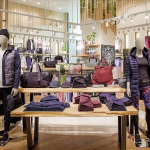The honors of presenting the Salomon division overview at adidas-Salomons Investor Day last week went to Christian Finell, who heads up Salomon for the Europe region. In reviewing the market, Finell said that Salomon had seen sales increase 400% since 1995 and was number one in a flat global winter sports market. He said that Germany and Japan were still weak, but was offset by the Emerging Markets area.
Finell said the brand has the top share position in alpine boot and is second in Alpine Skis when measured in value terms, but had the top spot in high-end skis. Finell said the lack of product at the entry-level price points keeps them out of the top spot. In the Snowboard business, Salomon is claiming the number three spot in boards and the number two position in boots. Salomon claims to own 80% of the Nordic Ski Systems market, thanks to their partnership with Fischer.
Reflecting a trend BOSS saw at the SIA.04 show, Salomon sees a shift in business from Snowboard to TwinTip skis and Freestyle. Finell said the Snowboard business had a small decline this year.
The Cross Country Ski business had a 5% gain, helped a great deal by strength in the Emerging Markets and better snow conditions.
Finell said that the Inline Skate business was the “trickiest” market, and we assume he wasnt referring to riding rails. He said Germany and the U.S. had a relatively big drop in business, pointing to aggressive price-points in the 20 to 40 range in Germany that have hurt the business. He said the Salomon average selling price was now in the 100 to 150 range versus 150 to 200 range. He stated that the market will need to see new innovation to drive the business.
Salomon sees strong growth opportunities in Outdoor Apparel and Footwear, an expectation that has helped push the Winter Sports to Summer Sports ratio to close to 50/50. Finell said they feel offerings must be much more “commercial” to expand the business. While Salomon claims the number one share position in Outdoor Performance Footwear, they look at the billion dollar businesses at Columbia and Quiksilver and a $300 million business at Merrell as proof positive of the potential for a outdoor-inspired casual and lifestyle business.
The reference to Quiksilver is a reflection of the companys move to establish a foothold in the Action Sports market. But they will not focus on apparel here until they gain credibility on the hardgoods side of the business, signified by their entry into the Surf market with a lightweight board that they say has been playing to strong user reviews.
One of the divisions key initiatives to drive Apparel sales is to evolve the sales organization to include dedicated softgoods reps.
In Europe, ArcTeryx and Bonfire also have new sales managers dedicated to building those businesses. Further growth is expected to be fueled through the companys focus on the female consumer through their “Women Will” program and the focus on more retail presence through shop-in-shop programs and other retail partnerships.
Operating margins are expected to see continued improvement as Salomon moves more production to Eastern Europe, primarily Romania. The company now has 52% of hardlines production coming from Romania versus 37% two years ago. Salomon expects to have 150,000 pairs of skis coming from Eastern Europe by 2005. Analysts questioned the companys reluctance to make the China move, a position Salomon said was due to the sourcing in Europe for most of the raw materials needed. Still, 90% of all Europe region shipments will originate from France, with the 10% fill-in orders coming from local area DCs.
Salomon sees margin improvement in binding production through lower labor costs. They expect ski gross margin to improve by five points.
The company is instituting early retirement plans and also plans to “make more efficient use of employees” versus temps. External recruiting has been frozen. Salomon said operating overhead in the U.S. has been cut 14% versus 2001, while Japan is down 24%.
The gains in margin will be a welcome development since Salomon continues to deliver operating margins that lag the balance of the adidas-Salomon group. Finell said they mist see 200 basis points improvement in the short term.
Salomon is forecasting single-digit annual growth, a figure that is held back due to the heavy reliance on winter sports, which leaves the company at the mercy of the weather each year. Finell said snow conditions have the biggest impact on growth. Much of that could change as Salomon moves to increase softgoods to 50% of the business in the next three to five years.













